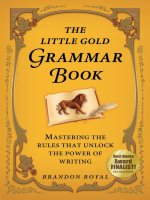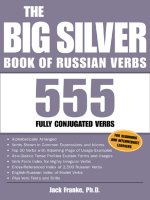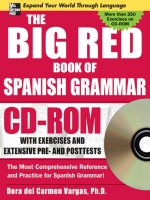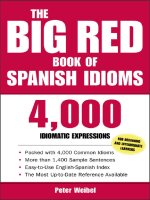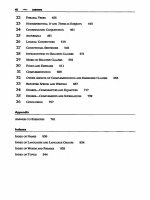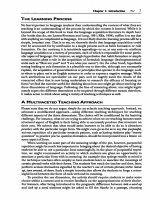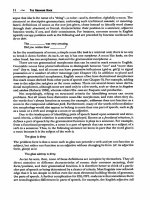big grammar book esol core curriculum mapping tool omt1
Bạn đang xem bản rút gọn của tài liệu. Xem và tải ngay bản đầy đủ của tài liệu tại đây (143.18 KB, 14 trang )
English Banana.com’s Big Grammar Book (ISBN 0 9546985 0 9)
UK Adult ESOL Core Curriculum Mapping Tool
Note: this information is provided as a guide only. Entry Level 1: black; Entry Level 2: orange
Page: Page Title: Curriculum Reference:
Curriculum references reproduced with permission from the Adult ESOL Core Curriculum published by DfES © Crown Copyright 2001
Page 1.
part one:
1 The English Alphabet Sc/E1.1b articulate the sounds of English to be comprehensible to a sympathetic native
speaker
Rw/E1.3a identify the letters of the alphabet in both upper and lower case
2 Writing the Alphabet 1 Rw/E1.3a identify the letters of the alphabet in both upper and lower case
Ww/E1.2a form the letters of the alphabet using upper and lower case
3 Writing the Alphabet 2 Rw/E1.3a identify the letters of the alphabet in both upper and lower case
Ww/E1.2a form the letters of the alphabet using upper and lower case
4 Personal Details - Completing Forms Rs/E1.1b use punctuation and capitalisation to aid understanding
Rw/E1.1a recognise a limited number of words, signs and symbols
Wt/E1.1a compose very simple text to communicate ideas or basic information
Ww/E1.1a use and spell correctly some personal key words and familiar words
5 Basic English Written Test Ws/E1.2a use basic punctuation to aid understanding of where sentences begin and end
Ww/E1.1a use and spell correctly some personal key words and familiar words
Ww/E1.1b use knowledge of basic sound-letter correspondence and letter patterns to aid
spelling
Ww/E1.1c develop strategies to aid spelling
6 Essential Spellings Rw/E1.1a recognise a limited number of words, signs and symbols
Rw/E1.3a identify the letters of the alphabet in both upper and lower case
Rw/E1.3b recognise digits
7 Vocabulary Test Ww/E1.1a use and spell correctly some personal key words and familiar words
Ww/E2.1a spell correctly the majority of personal details and familiar common words
English Banana.com’s Big Grammar Book (ISBN 0 9546985 0 9)
UK Adult ESOL Core Curriculum Mapping Tool
Note: this information is provided as a guide only. Entry Level 1: black; Entry Level 2: orange
Page: Page Title: Curriculum Reference:
Curriculum references reproduced with permission from the Adult ESOL Core Curriculum published by DfES © Crown Copyright 2001
Page 2.
8 Just Vowels - Days, Months and Ww/E1.1a use and spell correctly some personal key words and familiar words
Seasons 1 Ww/E1.1b use knowledge of basic sound-letter correspondence and letter patterns to aid
spelling
9 Just Vowels - Days, Months and Ww/E1.1a use and spell correctly some personal key words and familiar words
Seasons 2 Ww/E1.1b use knowledge of basic sound-letter correspondence and letter patterns to aid
spelling
10 Days of the Week Rw/E1.1a recognise a limited number of words, signs and symbols
11 Months of the Year Rw/E1.1a recognise a limited number of words, signs and symbols
12 Understanding Dates 1 Rt/E1.1b obtain information from texts
Rw/E1.3b recognise digits
Ww/E1.1a use and spell correctly some personal key words and familiar words
Ww/E1.2b form digits
13 Understanding Dates 2 Rt/E1.1b obtain information from texts
Rw/E1.3b recognise digits
Ww/E1.1a use and spell correctly some personal key words and familiar words
Ww/E1.2b form digits
14 Common Irregular Verbs Ws/E1.1a construct a simple sentence, using basic word order and verb form
(Present Simple Tense) Ww/E1.1a use and spell correctly some personal key words and familiar words
15 Common Irregular Verbs Ws/E2.1a construct simple and compound sentences using common conjunctions to
(Past Simple Tense) connect two clauses (e.g. as, and, but)
Ww/E2.1a spell correctly the majority of personal details and familiar common words
English Banana.com’s Big Grammar Book (ISBN 0 9546985 0 9)
UK Adult ESOL Core Curriculum Mapping Tool
Note: this information is provided as a guide only. Entry Level 1: black; Entry Level 2: orange
Page: Page Title: Curriculum Reference:
Curriculum references reproduced with permission from the Adult ESOL Core Curriculum published by DfES © Crown Copyright 2001
Page 3.
16 Common Irregular Verbs Ws/E2.1a construct simple and compound sentences using common conjunctions to
(Present Continuous Tense) connect two clauses (e.g. as, and, but)
Ww/E2.1a spell correctly the majority of personal details and familiar common words
17 Using Capital Letters 1 Rs/E1.1b use punctuation and capitalisation to aid understanding
Rw/E1.1a recognise a limited number of words, signs and symbols
18 Using Capital Letters 2 Rs/E1.1b use punctuation and capitalisation to aid understanding
Rw/E1.1a recognise a limited number of words, signs and symbols
19 Basic Sentence Punctuation 1 Rs/E1.1a read and recognise simple sentence structures
Rs/E1.1b use punctuation and capitalisation to aid understanding
Ws/E1.1a construct a simple sentence, using basic word order and verb form
Ws/E1.2a use basic punctuation to aid understanding of where sentences begin and end
Ws/E1.3a use basic punctuation to write about oneself
20 Basic Sentence Punctuation 2 Rs/E1.1a read and recognise simple sentence structures
Rs/E1.1b use punctuation and capitalisation to aid understanding
Ws/E1.1a construct a simple sentence, using basic word order and verb form
Ws/E1.2a use basic punctuation to aid understanding of where sentences begin and end
Ws/E1.3a use basic punctuation to write about oneself
21 Question Forms Using Verb ‘to be’ Rs/E1.1a read and recognise simple sentence structures
(Present Simple Tense) 1 Rs/E1.1b use punctuation and capitalisation to aid understanding
Ws/E1.1a construct a simple sentence, using basic word order and verb form
Ws/E1.2a use basic punctuation to aid understanding of where sentences begin and end
22 Question Forms Using Verb ‘to be’ Rs/E1.1a read and recognise simple sentence structures
(Present Simple Tense) 2 Rs/E1.1b use punctuation and capitalisation to aid understanding
Ws/E1.1a construct a simple sentence, using basic word order and verb form
Ws/E1.2a use basic punctuation to aid understanding of where sentences begin and end
English Banana.com’s Big Grammar Book (ISBN 0 9546985 0 9)
UK Adult ESOL Core Curriculum Mapping Tool
Note: this information is provided as a guide only. Entry Level 1: black; Entry Level 2: orange
Page: Page Title: Curriculum Reference:
Curriculum references reproduced with permission from the Adult ESOL Core Curriculum published by DfES © Crown Copyright 2001
Page 4.
23 Question Forms Using Verb ‘to be’ Rs/E1.1a read and recognise simple sentence structures
(Present Simple Tense) 3 Rs/E1.1b use punctuation and capitalisation to aid understanding
Ws/E1.1a construct a simple sentence, using basic word order and verb form
Ws/E1.2a use basic punctuation to aid understanding of where sentences begin and end
24 Question Forms Using Verb ‘to do’ Rs/E2.1d use punctuation and capitalisation to aid understanding
as an Auxiliary Verb Ws/E2.1a construct simple and compound sentences using common conjunctions to
(Present Simple Tense) 1 connect two clauses (e.g. as, and, but)
Ws/E2.3a use punctuation correctly, e.g. capital letters, full stops and question marks
25 Question Forms Using Verb ‘to do’ Rs/E2.1d use punctuation and capitalisation to aid understanding
as an Auxiliary Verb Ws/E2.1a construct simple and compound sentences using common conjunctions to
(Present Simple Tense) 2 connect two clauses (e.g. as, and, but)
Ws/E2.3a use punctuation correctly, e.g. capital letters, full stops and question marks
26 Question Forms Using Verb ‘to do’ Rs/E2.1d use punctuation and capitalisation to aid understanding
as an Auxiliary Verb Ws/E2.1a construct simple and compound sentences using common conjunctions to
(Present Simple Tense) 3 connect two clauses (e.g. as, and, but)
Ws/E2.3a use punctuation correctly, e.g. capital letters, full stops and question marks
27 Question Forms Using Verb ‘to have’ Rs/E2.1d use punctuation and capitalisation to aid understanding
as an Auxiliary Verb Ws/E2.1a construct simple and compound sentences using common conjunctions to
(Present Perfect Tense) 1 connect two clauses (e.g. as, and, but)
Ws/E2.3a use punctuation correctly, e.g. capital letters, full stops and question marks
28 Question Forms Using Verb ‘to have’ Rs/E2.1d use punctuation and capitalisation to aid understanding
as an Auxiliary Verb Ws/E2.1a construct simple and compound sentences using common conjunctions to
(Present Perfect Tense) 2 connect two clauses (e.g. as, and, but)
Ws/E2.3a use punctuation correctly, e.g. capital letters, full stops and question marks
English Banana.com’s Big Grammar Book (ISBN 0 9546985 0 9)
UK Adult ESOL Core Curriculum Mapping Tool
Note: this information is provided as a guide only. Entry Level 1: black; Entry Level 2: orange
Page: Page Title: Curriculum Reference:
Curriculum references reproduced with permission from the Adult ESOL Core Curriculum published by DfES © Crown Copyright 2001
Page 5.
29 Question Forms Using Verb ‘to have’ Rs/E2.1d use punctuation and capitalisation to aid understanding
as an Auxiliary Verb Ws/E2.1a construct simple and compound sentences using common conjunctions to
(Present Perfect Tense) 3 connect two clauses (e.g. as, and, but)
Ws/E2.3a use punctuation correctly, e.g. capital letters, full stops and question marks
30 Elementary Homophones 1 Lr/E2.2d listen for phonological detail
Rw/E2.3a use context and a range of phonic and graphic knowledge to decode words
31 Elementary Homophones 2 Lr/E2.2d listen for phonological detail
Rw/E2.3a use context and a range of phonic and graphic knowledge to decode words
part two:
32 Using Numbers 1 Rs/E1.1a read and recognise simple sentence structures
Rw/E1.1a recognise a limited number of words, signs and symbols
Rw/E1.3b recognise digits
Ww/E1.1a use and spell correctly some personal key words and familiar words
33 Using Numbers 2 Rs/E1.1a read and recognise simple sentence structures
Rw/E1.1a recognise a limited number of words, signs and symbols
Rw/E1.3b recognise digits
Ww/E1.1a use and spell correctly some personal key words and familiar words
34 Using Numbers 3 Rs/E1.1a read and recognise simple sentence structures
Rw/E1.1a recognise a limited number of words, signs and symbols
Rw/E1.3b recognise digits
Ww/E1.1a use and spell correctly some personal key words and familiar words
English Banana.com’s Big Grammar Book (ISBN 0 9546985 0 9)
UK Adult ESOL Core Curriculum Mapping Tool
Note: this information is provided as a guide only. Entry Level 1: black; Entry Level 2: orange
Page: Page Title: Curriculum Reference:
Curriculum references reproduced with permission from the Adult ESOL Core Curriculum published by DfES © Crown Copyright 2001
Page 6.
35 Using Numbers 4 Rs/E1.1a read and recognise simple sentence structures
Rw/E1.1a recognise a limited number of words, signs and symbols
Rw/E1.3b recognise digits
Ww/E1.1a use and spell correctly some personal key words and familiar words
36 Using Numbers 5 Rs/E1.1a read and recognise simple sentence structures
Rw/E1.1a recognise a limited number of words, signs and symbols
Rw/E1.3b recognise digits
Ww/E1.1a use and spell correctly some personal key words and familiar words
37 Working Out Prices 1 Rt/E1.2a recognise that the way a text looks can help predict its purpose
Rw/E1.3b recognise digits
Ww/E1.1a use and spell correctly some personal key words and familiar words
38 Working Out Prices 2 Rt/E1.2a recognise that the way a text looks can help predict its purpose
Rw/E1.3b recognise digits
Ww/E1.1a use and spell correctly some personal key words and familiar words
39 Ordinals 1 - Months of the Year Rw/E1.3b recognise digits
Ww/E1.1a use and spell correctly some personal key words and familiar words
40 Ordinals 2 - The Alphabet Rw/E1.3a identify the letters of the alphabet in both upper and lower case
Ww/E1.1a use and spell correctly some personal key words and familiar words
41 Opposite Adjectives 1 Rw/E1.1a recognise a limited number of words, signs and symbols
42 Opposite Adjectives 2 Rw/E1.1a recognise a limited number of words, signs and symbols
English Banana.com’s Big Grammar Book (ISBN 0 9546985 0 9)
UK Adult ESOL Core Curriculum Mapping Tool
Note: this information is provided as a guide only. Entry Level 1: black; Entry Level 2: orange
Page: Page Title: Curriculum Reference:
Curriculum references reproduced with permission from the Adult ESOL Core Curriculum published by DfES © Crown Copyright 2001
Page 7.
43 Comparatives and Superlatives 1 Rw/E2.2a recognise a range of familiar words and words with common spelling patterns
Ws/E2.2a use adjectives
44 Comparatives and Superlatives 2 Rw/E2.2a recognise a range of familiar words and words with common spelling patterns
Ws/E2.2a use adjectives
45 Comparatives and Superlatives 3 Rw/E2.2a recognise a range of familiar words and words with common spelling patterns
Ws/E2.2a use adjectives
46 Comparatives and Superlatives 4 Rw/E2.2a recognise a range of familiar words and words with common spelling patterns
Ws/E2.2a use adjectives
47 Using Indefinite Articles 1 Rw/E1.1a recognise a limited number of words, signs and symbols
Ws/E1.1a construct a simple sentence, using basic word order and verb form
48 Using Indefinite Articles 2 Rw/E1.1a recognise a limited number of words, signs and symbols
Ws/E1.1a construct a simple sentence, using basic word order and verb form
49 Countable and Uncountable Nouns 1 Rs/E2.1b use knowledge of simple and compound sentence structure to work out meaning
50 Countable and Uncountable Nouns 2 Rs/E2.1b use knowledge of simple and compound sentence structure to work out meaning
51 List of Common Uncountable Nouns Rw/E2.2a recognise a range of familiar words and words with common spelling patterns
52 Using “There are … “ & “There is … “ Rs/E2.1a use grammatical structures that link clauses and help identify sequence
Rs/E2.1b use knowledge of simple and compound sentence structure to work out meaning
Rw/E2.2a recognise a range of familiar words and words with common spelling patterns
Ws/E2.1a construct simple and compound sentences using common conjunctions to
connect two clauses (e.g. as, and, but)
Ww/E2.2a produce legible text
English Banana.com’s Big Grammar Book (ISBN 0 9546985 0 9)
UK Adult ESOL Core Curriculum Mapping Tool
Note: this information is provided as a guide only. Entry Level 1: black; Entry Level 2: orange
Page: Page Title: Curriculum Reference:
Curriculum references reproduced with permission from the Adult ESOL Core Curriculum published by DfES © Crown Copyright 2001
Page 8.
part three:
53 Using Personal Pronouns 1 Rs/E2.1b use knowledge of simple and compound sentence structure to work out meaning
54 Using Personal Pronouns 2 Rs/E2.1b use knowledge of simple and compound sentence structure to work out meaning
55 Using Personal Pronouns 3 Rs/E2.1b use knowledge of simple and compound sentence structure to work out meaning
56 Using Personal Pronouns 4 Rs/E2.1b use knowledge of simple and compound sentence structure to work out meaning
57 Using Personal Pronouns 5 Rs/E2.1b use knowledge of simple and compound sentence structure to work out meaning
58 Using Personal Pronouns 6 Rs/E2.1b use knowledge of simple and compound sentence structure to work out meaning
59 Adverbs of Frequency 1 Rw/E1.1a recognise a limited number of words, signs and symbols
Ww/E1.1a use and spell correctly some personal key words and familiar words
60 Adverbs of Frequency 2 Rs/E2.1b use knowledge of simple and compound sentence structure to work out meaning
Ws/E2.1a construct simple and compound sentences using common conjunctions to
connect two clauses (e.g. as, and, but)
61 Adverbs of Frequency 3 Rs/E2.1b use knowledge of simple and compound sentence structure to work out meaning
Ws/E2.1a construct simple and compound sentences using common conjunctions to
connect two clauses (e.g. as, and, but)
62 First Conditional 1 Rs/E2.1a use grammatical structures that link clauses and help identify sequence
Rs/E2.1b use knowledge of simple and compound sentence structure to work out meaning
63 First Conditional 2 Rs/E2.1a use grammatical structures that link clauses and help identify sequence
Rs/E2.1b use knowledge of simple and compound sentence structure to work out meaning
English Banana.com’s Big Grammar Book (ISBN 0 9546985 0 9)
UK Adult ESOL Core Curriculum Mapping Tool
Note: this information is provided as a guide only. Entry Level 1: black; Entry Level 2: orange
Page: Page Title: Curriculum Reference:
Curriculum references reproduced with permission from the Adult ESOL Core Curriculum published by DfES © Crown Copyright 2001
Page 9.
64 ‘Wh - ’ Questions 1 Rs/E1.1a read and recognise simple sentence structures
Ws/E1.1a construct a simple sentence, using basic word order and verb form
65 ‘Wh - ’ Questions 2 Rs/E1.1a read and recognise simple sentence structures
Ws/E1.1a construct a simple sentence, using basic word order and verb form
66 Compound Nouns 1 Rw/E2.3a use context and a range of phonic and graphic knowledge to decode words
Ww/E2.1b use their knowledge of sound-symbol relationships and phonological patterns
(e.g. consonant clusters and vowel phonemes) to help work out correct spellings,
as appropriate for the needs of the learner
Ww/E2.1c develop strategies to aid spelling
67 Compound Nouns 2 Rw/E2.3a use context and a range of phonic and graphic knowledge to decode words
Ww/E2.1b use their knowledge of sound-symbol relationships and phonological patterns
(e.g. consonant clusters and vowel phonemes) to help work out correct spellings,
as appropriate for the needs of the learner
Ww/E2.1c develop strategies to aid spelling
68 Compound Nouns 3 Rw/E2.3a use context and a range of phonic and graphic knowledge to decode words
Ww/E2.1b use their knowledge of sound-symbol relationships and phonological patterns
(e.g. consonant clusters and vowel phonemes) to help work out correct spellings,
as appropriate for the needs of the learner
Ww/E2.1c develop strategies to aid spelling
69 Daily Routines Rs/E2.1b use knowledge of simple and compound sentence structure to work out meaning
Rs/E2.1c apply own life experience and knowledge to monitor the meaning of sentences
as a whole when decoding unknown words
Ws/E2.1a construct simple and compound sentences using common conjunctions to
connect two clauses (e.g. as, and, but)
Ww/E2.1a spell correctly the majority of personal details and familiar common words
English Banana.com’s Big Grammar Book (ISBN 0 9546985 0 9)
UK Adult ESOL Core Curriculum Mapping Tool
Note: this information is provided as a guide only. Entry Level 1: black; Entry Level 2: orange
Page: Page Title: Curriculum Reference:
Curriculum references reproduced with permission from the Adult ESOL Core Curriculum published by DfES © Crown Copyright 2001
Page 10.
70 Complete the Sentences 1 Rs/E1.1a read and recognise simple sentence structures
Rw/E1.1a recognise a limited number of words, signs and symbols
Ws/E1.1a construct a simple sentence, using basic word order and verb form
Ws/E1.2a use basic punctuation to aid understanding of where sentences begin and end
71 Complete the Sentences 2 Rs/E1.1a read and recognise simple sentence structures
Rw/E1.1a recognise a limited number of words, signs and symbols
Ws/E1.1a construct a simple sentence, using basic word order and verb form
Ws/E1.2a use basic punctuation to aid understanding of where sentences begin and end
72 Complete the Sentences 3 Rs/E1.1a read and recognise simple sentence structures
Rw/E1.1a recognise a limited number of words, signs and symbols
Ws/E1.1a construct a simple sentence, using basic word order and verb form
Ws/E1.2a use basic punctuation to aid understanding of where sentences begin and end
73 Complete the Sentences 4 Rs/E1.1a read and recognise simple sentence structures
Rw/E1.1a recognise a limited number of words, signs and symbols
Ws/E1.1a construct a simple sentence, using basic word order and verb form
Ws/E1.2a use basic punctuation to aid understanding of where sentences begin and end
74 Complete the Sentences 5 Rs/E1.1a read and recognise simple sentence structures
Rw/E1.1a recognise a limited number of words, signs and symbols
Ws/E1.1a construct a simple sentence, using basic word order and verb form
Ws/E1.2a use basic punctuation to aid understanding of where sentences begin and end
75 Complete the Sentences 6 Rs/E1.1a read and recognise simple sentence structures
Rw/E1.1a recognise a limited number of words, signs and symbols
Ws/E1.1a construct a simple sentence, using basic word order and verb form
Ws/E1.2a use basic punctuation to aid understanding of where sentences begin and end
English Banana.com’s Big Grammar Book (ISBN 0 9546985 0 9)
UK Adult ESOL Core Curriculum Mapping Tool
Note: this information is provided as a guide only. Entry Level 1: black; Entry Level 2: orange
Page: Page Title: Curriculum Reference:
Curriculum references reproduced with permission from the Adult ESOL Core Curriculum published by DfES © Crown Copyright 2001
Page 11.
76 Sentence Building 1 Rs/E2.1a use grammatical structures that link clauses and help identify sequence
Rs/E2.1b use knowledge of simple and compound sentence structure to work out meaning
Rs/E2.1d use punctuation and capitalisation to aid understanding
Ws/E2.1a construct simple and compound sentences using common conjunctions to
connect two clauses (e.g. as, and, but)
77 Sentence Building 2 Rs/E2.1a use grammatical structures that link clauses and help identify sequence
Rs/E2.1b use knowledge of simple and compound sentence structure to work out meaning
Rs/E2.1d use punctuation and capitalisation to aid understanding
Ws/E2.1a construct simple and compound sentences using common conjunctions to
connect two clauses (e.g. as, and, but)
78 The Plays of William Shakespeare Rt/E2.1b obtain information from texts
Rs/E2.1a use grammatical structures that link clauses and help identify sequence
Rs/E2.1b use knowledge of simple and compound sentence structure to work out meaning
Rs/E2.1d use punctuation and capitalisation to aid understanding
Ws/E2.1a construct simple and compound sentences using common conjunctions to
connect two clauses (e.g. as, and, but)
part four:
79 Full Stops 1 Rs/E2.1a use grammatical structures that link clauses and help identify sequence
Rs/E2.1b use knowledge of simple and compound sentence structure to work out meaning
Rs/E2.1d use punctuation and capitalisation to aid understanding
80 Full Stops 2 Rs/E2.1a use grammatical structures that link clauses and help identify sequence
Rs/E2.1b use knowledge of simple and compound sentence structure to work out meaning
Rs/E2.1d use punctuation and capitalisation to aid understanding
English Banana.com’s Big Grammar Book (ISBN 0 9546985 0 9)
UK Adult ESOL Core Curriculum Mapping Tool
Note: this information is provided as a guide only. Entry Level 1: black; Entry Level 2: orange
Page: Page Title: Curriculum Reference:
Curriculum references reproduced with permission from the Adult ESOL Core Curriculum published by DfES © Crown Copyright 2001
Page 12.
81 Using Capital Letters 3 Rs/E2.1a use grammatical structures that link clauses and help identify sequence
Rs/E2.1b use knowledge of simple and compound sentence structure to work out meaning
Rs/E2.1d use punctuation and capitalisation to aid understanding
82 Using Capital Letters 4 Rs/E2.1a use grammatical structures that link clauses and help identify sequence
Rs/E2.1b use knowledge of simple and compound sentence structure to work out meaning
Rs/E2.1d use punctuation and capitalisation to aid understanding
83 Talking about the Past 1 Rs/E2.1b use knowledge of simple and compound sentence structure to work out meaning
Ww/E2.2a produce legible text
84 Talking about the Past 2 Rs/E2.1b use knowledge of simple and compound sentence structure to work out meaning
Ww/E2.2a produce legible text
85 Past Events - The Life of Captain Rt/E2.1a use a range of strategies and knowledge about texts to trace and understand
James Cook the main events of chronological and instructional texts
Rs/E2.1b use knowledge of simple and compound sentence structure to work out meaning
Ww/E2.2a produce legible text
86 Second Conditional 1 Rs/E2.1a use grammatical structures that link clauses and help identify sequence
Rs/E2.1b use knowledge of simple and compound sentence structure to work out meaning
87 Second Conditional 2 Rs/E2.1a use grammatical structures that link clauses and help identify sequence
Rs/E2.1b use knowledge of simple and compound sentence structure to work out meaning
88 Third Conditional 1 Rs/E2.1a use grammatical structures that link clauses and help identify sequence
Rs/E2.1b use knowledge of simple and compound sentence structure to work out meaning
89 Third Conditional 2 Rs/E2.1a use grammatical structures that link clauses and help identify sequence
Rs/E2.1b use knowledge of simple and compound sentence structure to work out meaning
English Banana.com’s Big Grammar Book (ISBN 0 9546985 0 9)
UK Adult ESOL Core Curriculum Mapping Tool
Note: this information is provided as a guide only. Entry Level 1: black; Entry Level 2: orange
Page: Page Title: Curriculum Reference:
Curriculum references reproduced with permission from the Adult ESOL Core Curriculum published by DfES © Crown Copyright 2001
Page 13.
90 Zero Conditional 1 Rs/E2.1a use grammatical structures that link clauses and help identify sequence
Rs/E2.1b use knowledge of simple and compound sentence structure to work out meaning
91 Zero Conditional 2 Rs/E2.1a use grammatical structures that link clauses and help identify sequence
Rs/E2.1b use knowledge of simple and compound sentence structure to work out meaning
92 Writing Comparisons 1 Wt/E2.1a compose simple text, selecting appropriate format for the purpose
Ws/E2.3a use punctuation correctly, e.g. capital letters, full stops and question marks
Ws/E2.4a use a capital letter for proper nouns
Ww/E2.2a produce legible text
93 Writing Comparisons 2 Wt/E2.1a compose simple text, selecting appropriate format for the purpose
Ws/E2.3a use punctuation correctly, e.g. capital letters, full stops and question marks
Ws/E2.4a use a capital letter for proper nouns
Ww/E2.2a produce legible text
94 Homophones 1 Lr/E2.2d listen for phonological detail
Rw/E2.3a use context and a range of phonic and graphic knowledge to decode words
Ww/E2.1b use their knowledge of sound-symbol relationships and phonological patterns
(e.g. consonant clusters and vowel phonemes) to help work out correct spellings,
as appropriate for the needs of the learner
95 Homophones 2 Lr/E2.2d listen for phonological detail
Rw/E2.3a use context and a range of phonic and graphic knowledge to decode words
Ww/E2.1b use their knowledge of sound-symbol relationships and phonological patterns
(e.g. consonant clusters and vowel phonemes) to help work out correct spellings,
as appropriate for the needs of the learner
English Banana.com’s Big Grammar Book (ISBN 0 9546985 0 9)
UK Adult ESOL Core Curriculum Mapping Tool
Note: this information is provided as a guide only. Entry Level 1: black; Entry Level 2: orange
Page: Page Title: Curriculum Reference:
Curriculum references reproduced with permission from the Adult ESOL Core Curriculum published by DfES © Crown Copyright 2001
Page 14.
96 List of Common Homophones Lr/E2.2d listen for phonological detail
Rw/E2.2a recognise a range of familiar words and words with common spelling patterns
Rw/E2.3a use context and a range of phonic and graphic knowledge to decode words
97 Being Polite Rt/E2.2a understand and identify the different purposes of short, straightforward texts
Rs/E2.1b use knowledge of simple and compound sentence structure to work out meaning
Rs/E2.1c apply own life experience and knowledge to monitor the meaning of sentences
as a whole when decoding unknown words
98 Good Advice 1 Rs/E2.1b use knowledge of simple and compound sentence structure to work out meaning
Rw/E2.2a recognise a range of familiar words and words with common spelling patterns
99 Good Advice 2 Rs/E2.1b use knowledge of simple and compound sentence structure to work out meaning
Rw/E2.2a recognise a range of familiar words and words with common spelling patterns
100 Good Advice 3 Rs/E2.1b use knowledge of simple and compound sentence structure to work out meaning
Rw/E2.2a recognise a range of familiar words and words with common spelling patterns
101 Write Your Own Flashcards Rw/E1.1a recognise a limited number of words, signs and symbols
Rw/E1.2a use knowledge of basic sound-letter correspondence to help sound out
unfamiliar words
Rw/E1.3a identify the letters of the alphabet in both upper and lower case
Rw/E1.3b recognise digits
Rw/E2.2a recognise a range of familiar words and words with common spelling patterns
Rw/E2.3a use context and a range of phonic and graphic knowledge to decode words
Rw/E2.5a sequence words using basic alphabetical ordering skills
